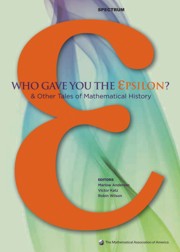Book contents
- Frontmatter
- Introduction
- Contents
- Analysis
- Foreword
- Who Gave You the Epsilon? Cauchy and the Origins of Rigorous Calculus
- Evolution of the Function Concept: A Brief Survey
- S. Kovalevsky: A Mathematical Lesson
- Highlights in the History of Spectral Theory
- Alan Turing and the Central Limit Theorem
- Why did George Green Write his Essay of 1828 on Electricity and Magnetism?
- Connectivity and Smoke-Rings: Green's Second Identity in its First Fifty Years
- The History of Stokes' Theorem
- The Mathematical Collaboration of M. L. Cartwright and J. E. Littlewood
- Dr. David Harold Blackwell, African American Pioneer
- Afterword
- Geometry, Topology and Foundations
- Algebra and Number Theory
- Surveys
- Index
- About the Editors
Highlights in the History of Spectral Theory
from Analysis
- Frontmatter
- Introduction
- Contents
- Analysis
- Foreword
- Who Gave You the Epsilon? Cauchy and the Origins of Rigorous Calculus
- Evolution of the Function Concept: A Brief Survey
- S. Kovalevsky: A Mathematical Lesson
- Highlights in the History of Spectral Theory
- Alan Turing and the Central Limit Theorem
- Why did George Green Write his Essay of 1828 on Electricity and Magnetism?
- Connectivity and Smoke-Rings: Green's Second Identity in its First Fifty Years
- The History of Stokes' Theorem
- The Mathematical Collaboration of M. L. Cartwright and J. E. Littlewood
- Dr. David Harold Blackwell, African American Pioneer
- Afterword
- Geometry, Topology and Foundations
- Algebra and Number Theory
- Surveys
- Index
- About the Editors
Summary
Not least because such different objects as atoms, operators and algebras all possess spectra, the evolution of spectral theory is one of the most informative chapters in the history of contemporary mathematics. The central thrust of the modern spectral theorem is that certain linear operators on infinite dimensional spaces can be represented in a “diagonal” form. At the beginning of the twentieth century neither this spectral theorem nor the word “spectrum” itself had entered the mathematician's repertoire. Thus, although it has deep roots in the past, the mathematical theory of spectra is a distinctly twentieth-century phenomenon.
Today every student of mathematics encounters the spectral theorem not later than his first course in functional analysis and often as early as his first course in linear algebra. Usually he studies one specimen of the spectral theorem, plucked out of historical context and imbedded in the logical context of his particular course. Although this scheme is pedagogically efficient and logically aesthetic, it does often obscure the fact that the spectral theorem was (and perhaps still is) an evolving species. Its evolution is an outstanding example of the counterpoint between pure and applied mathematics, for while the motive force in its evolution was the attempt to provide adequate mathematical theories for various physical phenomena, the forms through which it evolved are precisely those which have marked the development of modern abstract analysis.
So we offer here an austere outline of the evolution of the spectral theorem as a microcosmic example of the history of twentieth-century mathematics.
- Type
- Chapter
- Information
- Who Gave You the Epsilon?And Other Tales of Mathematical History, pp. 36 - 51Publisher: Mathematical Association of AmericaPrint publication year: 2009



